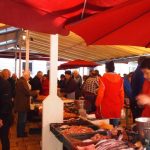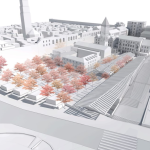April 1, 2020 – On Tuesday, March 31st, the Split fish market celebrated its 130th birthday.
The special birthday was welcomed closed, for the first time in history, a scenario that only a few could have imagined just a few weeks ago.
Slobodna Dalmacija writes that while we can no longer buy fish here, for the time being, we can talk about the importance of this Art Nouveau building, as well as the long traditions of the city related to the catch and sale of seafood.
Although not much attention was paid in official documents, the sale of fish and Split coexist, and even during the greatest crises, famines and wars, fish was on the local’s menu.
The first official record of the sale of fish in Split was found in the City Statute of 1312, in the section dealing with animals and products of animal origin. It states that “fishers must sell fish the day they arrive at a town port, in a fish market and not elsewhere. Types of sea bream were sold at eight dinars, Jack mackerels at two, tuna at three, mackerel at two, and all other fish at two dinars per libra. If the fishermen were to arrive at the harbor in the afternoon, he would have to bring the fish to the square early in the morning and sell it as said. “This is how it reads in the fourth book of the Statute, Chapter 116.
The Reformation Book states that “everyone who brought fish by sea or land to the city of Split or its district, so that he sold or carried it home, had to pay an eighth part, which they were obliged to pay anywhere they sold fish, both in and out of the Split district, and whether it was transported by boat or not.”
The rules, therefore, were very well known, as were the prices. With the fall of Dalmatia under Venice in 1409, the Venetian Republic on the eastern Adriatic Coast put fishers and fishing revenues under their control. Due to catches and fishing areas, mutual conflicts between Dalmatian communes were recorded. The Austrian Empire continued to bureaucratize and abandon fisheries. According to the “Statistical Notes on Dalmatia”, published in Vienna in 1818, fisheries are said to have once flourished and then declined because of the Venetian levies and other circumstances as fisher’s income had decreased.
In the paper “Fisheries of Dalmatia in the 19th and 20th Centuries”, by Điva Bašić, we learned about the average catch of the Split area, which in 1830 was 22,800 barrels of bluefish, 17,000 barrels of grey mullet, and about 220,000 of other fish. Fishing in Dalmatia three years later, during the summer and autumn, brought 20,576 thousand pieces of all kinds of fish, but the low price brought only a meager profit. As far as sales are concerned, it took place only at fish markets, which in Split, were in the city squares and on the waterfront, though it wasn’t a profitable job.
The “fisherman’s wife, eager for all the good” was a proverb that could not be easily eradicated in Dalmatia. At the end of the 19th century, the modern fish market was erected in the city, the one we use and are proud of today.
At the end of the last century, more precisely in 1890, according to the decision of architect Ante Bezic, a Solta native from Grohot, the Split fish market was built right next to the sulfur spa, which significantly contributed to the creation of its recognizable image as one of the few fish markets in the world without flies. Professor Frano Baras wrote that on March 31, 1890, at exactly 11 am, in the presence of municipal deputies and the general population, after the blessing of the canon of Dvornik, the new fish market was opened to the public by the Mayor, Gajo Filomen Bulat. It was the first public building to be built by the new Croatian municipal administration. “You almost don’t believe your eyes that such a big and tidy fish market could have come out of this old and gross enclosure,” historical sources said.
Under the design and supervision of the municipal technician Ante Bezic, the works began in July 1889. They were performed by the entrepreneur Ivan Celić. Due to technical difficulties, primarily around the skylight and hydrants, the works were completed in eight months. Meanwhile, fish were being sold on the benches in front of the monastery of St. Frane.
“Smooth stone tables lined up, a flat and mastered tiled floor, convenient faucet for washing fish and pumping water, beautiful iron door work by local artisans, and solid iron columns resting on a beautiful iron roof with glass openings, matching window panes – all this represents a harmonious perfect unit that you would not have hoped in the construction of this kind from afar,” the journalists wrote at the time.
Special praise went to the expense of the three iron gates, which were claimed to be incredibly low cost, and made by the valuable blacksmith Lovro Aržić. Split was thus awarded a fish market according to “all the requirements of taste, order and cleanliness”, one which were envied by much larger and more advanced cities. For the then 15,500 inhabitants, 30 outlets were erected at the fish market. It is known that the main sulfur springs are located at the site of the Obrov fish market. In the southwestern part of the building is a larger source of sulfur water, which was then used for the Split spa with galvanized pipes.
As the city grew, it was thought that the fish market should be larger, so in 1939 there was talk of “the need to build a bigger fish market three times the size“ at Matejuska. But World War II put an end to such dreams. Despite its long tradition, it is interesting to see how, on the eve of the war, the annual fish consumption in Japan was 45.5 kilograms per capita, in England 13.5, in Germany 9.5, in France 7.5, in Italy six, and the then Kingdom of Yugoslavia only half a kilo per capita.
It should be said that the new building delighted the citizens, and today the Secession building is admired mainly by tourists. In the bombing of the town on June 3, 1944, most of the Vidović house was demolished with the front-facing Marmontova Street, and after the rubble cleared in 1955, outdoor sales began. After three years, that is, in 1958, a famous and popular favorite market place was set up on the west side of the fish market. Lately, however, fish may only be sold indoors.
During the 1990s, the fish market was closed for about a year because it was being renovated. Sales were not suspended, but then moved to Morpurgo Field. Stands were set up and fish were offered to citizens every day, revealed Tvrtko Karoglan, director of Hippos, a concessionaire of the Split fish market.
The coronavirus pandemic has now stopped sales, but it’s clear fishers and sellers can’t wait to get back to their stands. The Split fish market is undoubtedly one of the most picturesque symbols fo the city, and today it is protected cultural property.
To read more about lifestyle in Croatia, follow TCN’s dedicated page.









